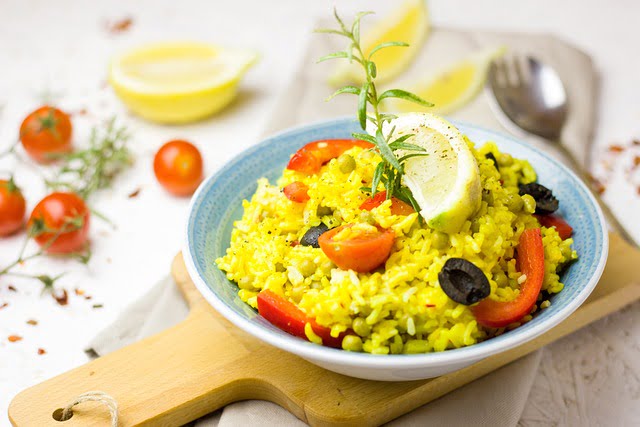Can dogs eat yellow rice?
Have you ever wondered if your dog can indulge in the vibrant and aromatic world of yellow rice? As a pet owner, it’s natural to want to share tasty treats with your beloved dog. But when it comes to their health, it’s important to understand which foods are safe for them. In this guide, we will delve into the question: Can dogs eat yellow rice? We will also go as far as we can to uncover the truth, explore the potential benefits and risks, and discover suitable alternatives to ensure your dog’s well-being. So, let’s embark on this flavorful journey together as we find out if your pup can savor the tantalizing taste of yellow rice!
What is yellow rice?
Yellow rice, also known as saffron rice, is a delectable and visually appealing dish that adds a burst of color to any meal. It is a popular culinary creation made by combining long-grain rice with various spices, most notably turmeric or saffron, which give the rice its distinctive yellow hue.
The process of making yellow rice involves infusing the rice with the vibrant colors and flavors of the spices. Turmeric, a bright yellow spice derived from the Curcuma longa plant, is often used to impart a golden-yellow color to rice. Saffron, a prized and expensive spice derived from the Crocus sativus flower, is another option for achieving the vibrant yellow shade in the rice.
In addition to turmeric or saffron, yellow rice can be enhanced with other seasonings and ingredients such as onions, garlic, cumin, cinnamon, and bay leaves. These additions contribute to the delightful aroma and complexity of flavors found in this beloved dish.
Yellow rice is a versatile staple in various cuisines around the world. It is commonly enjoyed in Latin American, Indian, Caribbean, and Middle Eastern cooking. This flavorful rice can be served as a side dish to accompany a variety of main courses, including chicken, seafood, vegetables, or curries.
Now that we have explored what yellow rice is and its cultural significance, let’s move on to the main question at hand: Can dogs eat yellow rice?
Related articles
- How much Avocado will kill a dog?
- Best time to feed dogs so they don’t poop at night
- Can Dogs Eat Tangerines? A Must Read
Can dogs eat yellow rice?
Yes, dogs can eat yellow rice in moderation, as long as it is prepared without harmful ingredients such as onions, garlic, or excessive salt. It’s important to be mindful of the potential risks and to prioritize a balanced diet tailored to a dog’s specific nutritional needs.
Benefits of yellow rice for dogs
Yellow rice, when prepared without harmful ingredients, can offer some potential benefits for dogs in moderation:
- Carbohydrate Energy: Yellow rice is primarily composed of carbohydrates, which can provide a source of energy for dogs. Carbohydrates play a role in fueling bodily functions and supporting physical activities.
- Gentle on the Digestive System: Rice, including yellow rice, is known for its gentle nature on the digestive system. It can be helpful in cases of mild gastrointestinal upset or as a bland option for dogs with sensitive stomachs.
Risks of feeding yellow rice to dogs
While yellow rice may have potential benefits, it’s crucial to be aware of the potential risks involved.
- Harmful ingredients: Many yellow rice recipes include ingredients such as onions, garlic, or excessive salt, which can be toxic or harmful to dogs. Onions and garlic, in particular, contain compounds that can damage a dog’s red blood cells, leading to a condition called hemolytic anemia.
- High carbohydrate content: Dogs are primarily carnivores, and their bodies are designed to metabolize protein as their main energy source. A diet excessively high in carbohydrates, including yellow rice, may lead to weight gain, digestive issues, or other health problems over time.
- Allergies or sensitivities: Some dogs may have specific food allergies or sensitivities, including grains like rice. It’s essential to observe your dog for any adverse reactions, such as skin irritations, gastrointestinal upset, or changes in behavior, after consuming yellow rice.
Suitable alternatives to yellow rice for dogs
If you’re looking for alternative options to incorporate into your dog’s diet, consider the following:
Plain rice
Plain, cooked white or brown rice can be a suitable and easily digestible alternative to yellow rice for dogs. It provides carbohydrates without the potential harmful ingredients found in seasoned yellow rice.
Lean protein sources
Incorporating lean protein sources such as boiled chicken, turkey, or fish with rice can provide a balanced meal for your dog. Protein is a vital nutrient for dogs, supporting muscle development and overall health.
Commercial dog food
Opting for high-quality commercial dog food that meets your dog’s specific nutritional requirements is often the best choice. These formulas are carefully formulated to provide a balanced diet tailored to a dog’s needs.
Nutritional content of Yellow rice for dogs
When considering the nutritional content of yellow rice specifically for dogs, it’s important to understand their unique dietary requirements. Let’s look at the nutritional content of yellow rice for dogs:
Carbohydrates
Yellow rice is primarily composed of carbohydrates, which provide a source of energy for dogs. Carbohydrates play a role in fueling bodily functions and supporting physical activities. However, dogs have a lower requirement for carbohydrates compared to humans, as they are primarily carnivorous animals.
Dietary Fiber
Yellow rice contains dietary fiber, which can support digestive health in dogs. Fiber aids in promoting regular bowel movements, preventing constipation, and supporting a healthy gastrointestinal system. However, dogs typically have a lower requirement for dietary fiber compared to humans, as their digestive systems are adapted to a primarily meat-based diet.
Protein
According to our findings, 100g of yellow rice contains about 4.8g of protein, which is about the same as 0.8g of eggs, 0.2g of chicken breasts, or 0.3 cups (93g) of black rice. Protein is an essential nutrient for dogs and is very important for various physiological functions, including muscle development, tissue repair, enzyme production, and hormone synthesis. Although dogs require higher levels of protein in their diet compared to humans, it is also crucial that you prepare the yellow rice with animal-based protein foods such as meat, fish, or specific dog food formulas.
Essential vitamins and minerals
Yellow rice contains various essential vitamins and minerals, although the levels and bioavailability of these nutrients may not be optimal for dogs. Dogs have specific vitamin and mineral requirements that differ from humans, and their diets should be carefully formulated to meet these needs. It’s important to note that the vitamin and mineral needs of dogs can vary depending on factors such as age, breed, size, and health status.
Harmful Ingredients
When we were answering the question, “Can dogs eat yellow rice?” we pointed out that yellow rice should be given to your dogs in moderation, if at all you choose to feed them with it. The reason for this, as we’ve mentioned above, is the presence of potentially harmful ingredients in some yellow rice.
Some yellow rice recipes include ingredients such as onions, garlic, or excessive salt, which can be toxic or harmful to dogs. So, it’s important to ensure that any yellow rice offered to dogs is free from these harmful additives.
Read also>> Is Neosporin Safe for Dogs?
How to Safely Incorporate Rice into Your Dog’s Diet
If you decide to include rice in your dog’s diet, follow these guidelines for safe consumption:
Consult with a veterinarian
Before introducing any new food, such as yellow rice, into your dog’s diet, it’s best to consult with a veterinarian, if you can access one. They can assess your dog’s specific nutritional needs, consider any health conditions or allergies, and provide personalized guidance on incorporating rice or other ingredients.
Choose the right type of rice
When incorporating rice into your dog’s diet, opt for plain, cooked rice rather than seasoned varieties. Yellow rice can contain ingredients like onions or garlic, which can be toxic to dogs. Stick to white or brown rice, which is easy to digest and contains fewer potential allergens.
Start slowly and monitor
Introduce rice gradually into your dog’s diet to allow their digestive system to adjust. Start with small portions mixed with their regular food, and observe for any signs of digestive upset or allergic reactions. If your dog tolerates rice well, you can gradually increase the portion size over time.
Cook rice thoroughly
Ensure that the rice is cooked thoroughly to enhance digestibility and maximize nutrient availability. Undercooked rice can be difficult for dogs to digest, leading to gastrointestinal discomfort. Cook the rice until it is soft and easily chewable.
Balance rice with other nutrients
While rice can be included as part of a balanced diet for dogs, it should not be the sole component. Dogs require a balanced mix of proteins, fats, carbohydrates, vitamins, and minerals. Incorporate rice alongside high-quality protein sources, such as lean meats or specific dog food formulas, to ensure your dog’s nutritional needs are met.
Portion control
Maintain portion control when feeding rice to your dog. Remember that rice, including yellow rice, is higher in carbohydrates, which can contribute to weight gain if overconsumed. Adjust the portion size of rice based on your dog’s size, activity level, and overall dietary needs.
Monitor your dog’s weight and overall health
Regularly monitor your dog’s weight and overall health when incorporating rice into their diet. If you notice any weight gain, signs of digestive upset, or other health issues, consult with your veterinarian to adjust the diet accordingly.
Read also>> My dog won’t eat breakfast but eats dinner (Here’s what to do)
Can dogs have saffron spice?
No, dogs should not have saffron. Saffron is not toxic to dogs, but it is not recommended to give them saffron as it doesn’t provide any significant health benefits for them. Additionally, some dogs may have allergic reactions to saffron. It’s best to stick to a balanced diet specifically designed for dogs and consult with a veterinarian before introducing any new spices or ingredients to their diet.
Is yellow rice good for puppies?
Yellow rice is not really bad for puppies, but it should be fed in moderation and with caution. Puppies have specific nutritional needs for their growth and development, and a balanced diet tailored to their requirements is essential. While yellow rice can provide some energy and be easily digestible, it should not be the main component of a puppy’s diet. Consult with a veterinarian to ensure you are providing the appropriate diet for your puppy’s specific needs.
What happens if I feed my dog uncooked rice?
Feeding your dog uncooked rice can potentially cause digestive issues and discomfort. Uncooked rice is difficult for dogs to digest and can lead to gastrointestinal upset, including symptoms such as bloating, gas, and even potential obstruction in severe cases. It’s important to cook rice thoroughly before feeding it to your dog to ensure it is easily digestible and safe for consumption.
Can dogs eat yellow basmati rice?
Yes, dogs can eat yellow basmati rice as long as it is plain and cooked without any harmful seasonings or ingredients. Yellow basmati rice is a variant of basmati rice with a golden hue and a slightly nutty flavor. It can be a source of carbohydrates and energy for dogs.
Can dogs eat Vigo yellow rice?
No, it is not recommended to feed dogs Vigo Yellow Rice or any seasoned rice mixes specifically formulated for human consumption. These rice mixes often contain ingredients like onions, garlic, or excessive salt, which can be toxic or harmful to dogs.
Can dogs eat Spanish yellow rice?
Dogs can eat Spanish yellow rice as long as it is prepared without harmful ingredients and seasonings. Spanish yellow rice typically includes ingredients like saffron, spices, and sometimes vegetables.
How is Spanish yellow rice different from yellow rice?
Spanish yellow rice is a specific variation of yellow rice that is often seasoned with ingredients like saffron, spices, and sometimes vegetables. It typically has a distinctive flavor and aroma, influenced by the spices used in Spanish cuisine. On the other hand, yellow rice in general refers to any rice that has been colored or flavored with ingredients such as turmeric, annatto, or saffron. While Spanish yellow rice is a type of yellow rice, it has its own unique flavor profile and is often associated with Spanish or Latin American dishes.
Should dogs eat Spanish rice with saffron?
It is generally not recommended to feed dogs Spanish rice with saffron. While saffron itself is not toxic to dogs, it is not necessary for their diet and may not provide significant health benefits. Additionally, some dogs may have allergies or sensitivities to saffron.
How can rice help dogs with diarrhea?
Rice can be beneficial for dogs with diarrhea due to its bland and easily digestible nature. Here’s how rice can help:
- Binding Effect: Rice has a binding effect on loose stools, helping to firm them up. The starches in rice can help regulate bowel movements and provide relief from diarrhea.
- Digestive Support: Rice is gentle on the digestive system, making it easier for dogs to tolerate when they have an upset stomach. It provides a source of easily digestible carbohydrates that can be gentle on the irritated digestive tract.
- Nutritional Support: Rice is a good source of energy and can help provide nutrients during episodes of diarrhea, when dogs may have a reduced appetite. It offers a balance of carbohydrates and some essential nutrients.
Conclusion
While yellow rice can be a flavorful and enticing dish for humans, it’s important to exercise caution when considering feeding it to your dog. We always advise you to stick with plain, cooked rice because of the presence of harmful seasonings in some types of yellow rice. Not just that, the high carbohydrate content may not align with your dog’s dietary needs. If possible, consult with your veterinarian before introducing yellow rice to your dog’s diet.



